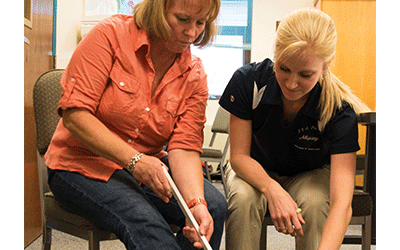FOR IMMEDIATE RELEASE
FOR MORE INFORMATION
Kristin Kehrwald 301-784-5152

ACM is accepting applications for its next cohort of occupational therapy assistant
program students. The deadline to apply for the academic program is Apr. 15 with phase
II (clinical) courses beginning in summer of 2022.
PROBLEM SOLVERS FIND PURPOSE IN OCCUPATIONAL THERAPY:
Allegany College of Maryland’s Occupational Therapy Assistant Program Welcomes Applicants
CUMBERLAND, Md. (Jan. 3, 2022) – Allegany College of Maryland’s occupational therapy assistant program, one of only four such programs in Maryland, is accepting student applications
for its 2022 cohort. The deadline to apply for the academic program is Apr. 15 with phase II (clinical)
courses beginning in summer of 2022. Full-time students may earn their associate degree in four semesters, including two
eight week-long clinical placements, before testing to becoming certified occupational
therapist assistants (COTAs). Occupational therapy assistants frequently work in public
schools, hospitals, rehabilitation centers, mental health centers, and nursing homes,
and other community settings with individuals who have lost abilities or skills due
to an injury, illness, or medical condition.
Holistic Approach
“It’s a career for compassionate problem solvers. As a working OTA, you quickly discover your client’s uniqueness and you learn to think
on your feet,” said Jeff Hopkins, program director and a registered occupational therapist. “Working
at the direction of occupational therapists, OTAs plan for their clients’ needs in
real time while striving to help them live with dignity at every stage of their lives.”
The program emphasizes a holistic understanding of how the mind and body work coupled with proven
strategies and skills attainment. It’s a program that teaches students to expect the
unexpected.
- Whether they’re assuming the role of an individual getting ready for work, leading
a mock group session in mental health center, building adaptive equipment for an elementary
student or fixing brakes on a wheelchair, occupational therapy assistant students learn to adapt quickly.
- Students work independently and as a team to develop client-driven activities, exercises,
adaptive devices.
- They learn to modify daily living tasks, and leisure activities to promote independence
for their patients.
- Many of the courses include fieldwork components which serve to solidify concepts
learned in the classroom and labs.
After Graduation
ACM’s occupational therapy assistant program graduates earn their Associate in Applied
Science degree and become eligible to take the national certification examination
to become a Certified Occupational Therapy Assistant.
- COTAs, working under the supervision of an occupational therapist, help individuals
with physical, developmental or emotional disabilities to live independently.
- Many OTAs elect to transfer their associate degree to a Bachelor of Science/Master
of Occupational Therapy (BS/MS) program.
- A Master of Science degree is the entry level degree required for Registered Occupational
Therapists.
“Not only is this affordable program for an entry-level OTA position, it’s an easily
transferrable academic program for individuals who are interested in becoming registered
occupational therapists or OTRs,” said Hopkins, who became a registered occupational
therapist in 1982.
Reputation for Great Hires
Stacey Warnick, physical therapist and owner of School Therapy Services in Frostburg, understands the importance of hiring well-trained professionals. Her
team of more than 40 therapists and therapist assistants provide school-based occupational
and physical therapy services to more than 800 students in Allegany, Garrett, Hardy
and Pendleton county school systems. Her employees help K-12 students develop and
improve their abilities so they can more readily adapt to their school environment
and access their educational materials.
“When we’re hiring, ACM is always the first program we contact because we know their
graduates will be professional, respectful, and ready for entry-level therapy positions,”
said Warnick. “Also as a clinical site for the program, the students we host are eager
to learn and gain new skills.”
Karen Shambaugh, an occupational therapist and owner of X-Cel Performance Rehab, echoed Warnick’s comments. With offices in Romney and Short Gap, she leads a team
of 10 occupational and physical therapists and therapy assistants. Having hired ACM
graduates in the past, Shambaugh states that she has no hesitation pursuing ACM graduates
to add to her X-Cel team of professionals. Her own focus as an occupational therapist
has been in upper extremity and lymphedema management for more than 20 years.
National Shortage of OTAs
The national Bureau of Labor Statistics predicts a 36 percent increase from 2020 to
2030 in terms of the overall employment of occupational therapy assistants.
- OTAs will be needed to assist the country’s increasing older adult population that
face medical conditions that impact their abilities to perform everyday activities
as well as children and younger adults with developmental disabilities.
- Many OTAs are currently assisting individuals in regaining skills as part of their
recovery from COVID-19.
ACM’s occupational therapy assistant program is designated as a Health Manpower Shortage
Program by the Maryland Higher Education Commission, meaning that the Maryland State
Department of Health and Mental Hygiene has determined it to be an in-demand health
occupation where qualified workers are in short supply.
Unique to Area
With the limited number of OTA programs in Maryland and West Virginia, the program
attracts students from outside the region. The program’s small cohort of students,
which includes a number of West Virginia residents, easily become a tight-knit group.
Hopkins, who founded the program in 1994 returned earlier this year as its director.
Alex Grimm, a 2018 graduate of the program, oversees the program’s clinical placements.
The program has two phases: a general education phase and a clinical phase.
Scholarships Available
The ACM Foundation offers four scholarships with multiple awards each specifically for occupational therapy assistant students.
For program information or to enroll in the occupational therapy assistant program,
visit www.allegany.edu/ota or contact Jaime Andres, the program’s administrative associate, at 301-784-5538.






